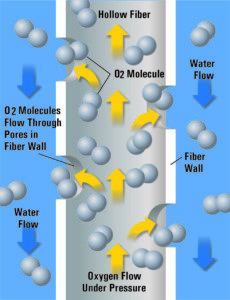
Water You Missing?
Forty, even 30, years ago, we watered our plants, dropped in a little fertilizer, and hoped for the best. Perhaps it wasn’t quite that simple, but our main focus with irrigation was primarily making sure plants didn’t dry out.
Today, greenhouse production is much more sophisticated, but what if you could get even more from your water? Research shows us that managing a few factors can help your plants get the most from irrigation. Here are the three we suggest starting with.
BIOFILMS
While sanitation is a critical part of every successful greenhouse protocol, we’ve learned that biofilms can sabotage quality plants faster than you think — and they are found in even the most pristine greenhouses.

fibers, where it undergoes the oxygen infusion process.
Biofilms are the thin films inside pipes and tanks. They are a significant player in distribution of pathogens, particularly for simple pests like Pythium, Phytophthora and algae. While the typical assumption has been that sanitizing source water, whether well, rain or municipal, would result in the cleanest water possible for greenhouse plants, what we didn’t realize was that biofilms are a serious threat to the plant world — even in greenhouses built just six months ago.
These biofilms provide a safe harbor for pathogenic microbes, and every time you turn on the water, some of those pathogens are distributed with the irrigation. “Most of the time, it’s not a high enough concentration to affect the plant — like you and I can fight off a cold most of the time,” says Al Zylstra, manager of DRAMMwater. “But once or twice a year, if you don’t have your biofilms under control, you end up with an outbreak.” And if you don’t completely remove the biofilms, those outbreaks become much more frequent.
Successful sanitation means not just sanitizing source water but also pipes, tanks, drip irrigation and irrigation systems to remove biofilms. To do that, growers have several options.
“Pure chlorine cleans source water, but it doesn’t affect the hard-to-kill central glycocalyx of biofilms,” Zylstra explains. Chlorine dioxide will, but it has a long halflife, which means it takes a long time to kill biofilms. Because it lasts so long, it also has the potential to impact the root system of the plant, damaging the fine root hairs. It can also end up in drain water because it has such a long half-life.
Activated hydrogen peroxide is milder than chlorine dioxide, and it is effective against biofilms. But it can also affect the plant’s root system and overall health.
Ozone, the most powerful oxidizer available, acts very quickly against pathogens — 3,500 times faster than chlorine. It kills on contact, and then it disappears without harming the plant. An unstable gas, it has a 20-minute half-life in the air, and a less than five-minute half-life in irrigation. As soon as it leaves the emitter, it undergoes a pressure change and is gone as soon as it hits the growing media.

DISSOLVED OXYGEN
Oxygen is required for life; it’s in water, so our plants have what they need from irrigation, right? Turns out, if you provide plants even more oxygen, they thrive even more.
We know roots need oxygen — that’s why farmers till fields, and why greenhouse growers spend so much time getting their media right. What we’ve also learned is that even if you don’t have your biofilm under control, you can slow its growth if you’re providing enough oxygen in the water. You can do that by infusing dissolved oxygen into the water.
But don’t plants get oxygen in irrigation water? Yes, but your plants need maximum available dissolved oxygen to get the nutrients they need. Second, typical well and city water only contains 4- to 8-ppm dissolved oxygen. Research indicates that the optimal dissolved oxygen level for plant production is 18 to 25 ppm.
Typically, injecting dissolved oxygen is a very energy-intensive process in which the bubbles produced help to rob results, providing only minor increases in oxygen. The newest dissolved oxygen systems accomplish results without bubbles. In the newest molecular oxygen infusion system, irrigation water is made to flow over special fiber materials contained in a canister. These fibers are pressurized with pure oxygen and are made with tiny “pores” that admit molecules of oxygen, not bubbles, into the stream in between water’s H2O molecules, where they remain in stable suspension throughout the irrigation process.
These systems reach those levels of efficiencies through mass transfer, which produces stable liquid streams with very high dissolved oxygen levels — readings typically seen only in laboratories. Dissolving oxygen in water without bubbles allows the system to achieve the high stability needed to ensure maximum oxygen gets to plants and their roots. For example, in trials with the TOOB molecular oxygen infusion system, growers report a 15% reduction in nutrient costs and an 11% yield increase.
A plant’s metabolic rate is throttled by how much oxygen is exchanged. That’s why dissolved oxygen works — and even better, it’s one of the most economical ways to amend water.
TEMPERATURE
Irrigation water temperature is another crucial factor, because plants shut down at a certain temperature and express dissolved oxygen at other temperatures.
Above 80° F, there is no room for dissolved oxygen, especially in hot climates like Florida, the southeast and the southwest. There, the best approach is to chill water to retain dissolved oxygen and reduce microbial growth.
On the other end of the spectrum, most of the plant kingdom shuts down at 59° F — the root system stops when the water is too cold. Essentially, we’re shocking the plant, and its reaction is to stop growing.
In trials at a Florida nursery, we encountered a crop that took a year to grow. We provided bottom heat to warm the root system and keep the temperature where it needed to be, and the production time decreased from 12 months to 7 months. Temperature matters.
Usually, we’re targeting temperatures of 68 to 72° F; that’s the sweet spot where both plant and root system stay active. The biggest mistake a grower can make is not doing anything about water temperature, or thinking the only option is traditional strategies like water chillers. We see growers buying water chillers instead of buying a dissolved oxygen system. It’s important to remember that the plant doesn’t necessarily object to warmer temperatures; rather, it loses its ability to retain dissolved oxygen. If temperatures are too high, you could chill the water, or you could add dissolved oxygen. Either works, and adding dissolved oxygen offers a host of additional benefits.
One of the most common mistakes we see is installing a system that’s bigger than it needs to be. For example, when you water all plants in a four-hour space, your irrigation is pumping 85 gallons a minute. The water tempering system is designed to take water from 50 to 70° F, and that takes a large boiler or heat exchanger. Instead, put in a tank, and you have 20 hours a day to heat. Now, you have 17 gallons a minute that you have to heat, not 85. Average the system instead. Put it into a tank, and average it over an extended period of time instead of heating it on the fly.
Something else we often see with growers in warmer climates: They believe they don’t need to heat their water. But that may be because they don’t know the temperature of their water. If a well is 1,000 feet down, the water may be 52 to 55° F. The same may be true if you pull water from a freshwater river, lake or stream. Likewise, don’t think that because you live in the North you don’t have to chill your water. Hot days and high sun on a tank can quickly change water temperature.
Margins keep shrinking, and what you could afford to ignore 10 years ago, now makes the difference in finishing a quality crop faster. Water you missing?


 Video Library
Video Library 




















